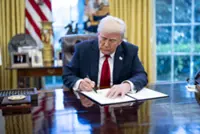
The implications of the Trump administration’s reciprocal tariff policy on South-East Asia are still unclear, as certain questions need to be answered. — TNS
THE first few months of US President Donald Trump’s administration have been characterised by erratic changes to trade policy. The administration has slapped new tariffs of 10%-25% on Canada, China, and Mexico, only to defer them more than once.
The earlier threat of an across-the-board tariff, where imports from all countries are taxed at the same rate, may have been replaced by a reciprocal tariff policy. The implications of the new policy for South-East Asia are still indeterminate, as many questions remain unanswered.
Trump announced the new policy during his first address to Congress, to take effect from Wednesday onwards. With this policy, US tariffs will be set to match those faced by US exporters in each country, product by product.
The Feb 13 White House memorandum that details this plan also considers “any other practice” that “imposes any unfair limitation on market access or any structural impediment to fair competition”. This includes value-added taxes and non-tariff barriers (NTBs) such as regulatory requirements, subsidies, and exchange rate policies. In other words, each trading relationship will be examined in its entirety.
Measuring the tariff-equivalent of these types of NTBs is complex and subject to error and manipulation. Will the US also measure the tariff equivalent of NTBs operating in its market? These have increased substantially during the Biden administration, with massive increases in subsidies and the flagrant use of export and import controls.
One transparent measure of the unequal treatment of each other’s trade is the difference in average tariff rates. The differences with the US are relatively small because most Asean countries have been multilateralising their preferential tariffs, offering them to the US and other trading partners on a Most Favoured Nation (MFN) basis.
The weighted average tariff that US exporters face in South-East Asian countries slightly exceeds those faced by South-East Asian exporters to the US in all countries except Indonesia. In 2023, the difference was highest for Thailand, but at only 3%, followed by the Philip-pines at below 2%, Malaysia at below 1%, and Vietnam at about 0.2%.
While tariffs in Asean have been falling sharply, NTBs have been rising. Therefore, these differences may underestimate the true protection facing US exporters and could provide US authorities with the grounds for raising tariffs significantly, especially if they ignore NTBs in the US in calculating the difference. After all, the policy is not being introduced as a liberalisation tool but to pursue a self-confessed love of tariffs by Trump, which he sees as a way of raising revenue from foreigners under the guise of pursuing fair trade.
There will be winners and losers from this policy, and a lot will depend on how it is implemented and what it is compared with. For instance, if it is compared with the status quo (ie, no new tariffs), then the impact will be unambiguously negative.
Compared with the proposed across-the-board tariff, which would not affect the relative competitiveness of individual countries, the newer reciprocal tariff policy will create winners and losers depending on the tariffs that a particular country levies on imports from the US.
If this policy replaces unilateral tariffs based on metrics like bilateral trade deficits, this will also create winners and losers but remove the uncertainty of unpredictable changes.
(Trump said last Wednesday that the reciprocal levi rates would be lower than expected in his sweeping tariff push this week: “We are going to make it all countries, and we are going to make it very lenient,” Trump told reporters in the Oval Office.)
In general, the impact will also depend on the importance of the US as a trading partner. Some countries in South-East Asia will be more vulnerable than others. In 2024, Vietnam’s share of exports to GDP destined for the US was about 25%, Malaysia and Thailand just above 10% each, and Singapore about 7%.
As of November 2024, Vietnam’s trade surplus in goods and services with the US stood at US$112bil (RM496bil), followed by Thailand with US$40bil (RM177bil) and Malaysia at US$23bil (RM101bil).
The impact across South-East Asian countries will be industry-dependent, varying by their importance in trade and the level of protection.
As a share of total exports to the US in 2024, electronics accounted for more than 60% for Malaysia and the Philippines, 45% for Thailand, 43% for Vietnam, and about a third for Singapore. Textiles, clothing, and footwear accounted for about 30% for Indonesia and a quarter for Vietnam.
Food and agricultural products accounted for above 10% for Indonesia, and almost 10% for the Philippines and Thailand. Electronics and textiles have relatively low tariffs in both directions, although food and agriculture are highly protected through subsidies and other NTBs by both but more so by the US.
Implementation difficulties could raise transaction costs and derail any potential benefits. Determining the origin of a product in a world of global supply chains is increasingly difficult and costly. The cost of implementing the reciprocal trade policy is akin to the US implementing a free trade agreement (FTA) with every trading partner.
As Alan Deardoff has shown, the cost of implementing ubiquitous FTAs yields lower welfare for everyone compared with if there were no FTAs at all, or if all trade were subject to a common MFN tariff.
That is, a country is better off even with a common tariff compared with lower preferential tariffs in an FTA because of the high cost of implementing the latter. Similarly, a reciprocal tariff policy would, like an FTA, incur the same high costs.
With so much still unknown regarding the implementation of the reciprocal tariff policy, it is difficult to determine its net impact on the region or the world.
Will it remove the erratic and unpredictable aspect of Trump’s trade policy, or will it simply add a new mechanism to impose tariffs? That is, will it set a ceiling on the maximum tariff to be imposed by the US, or will some countries still be singled out and punished indiscriminately, risking retaliation?
For now, the net impact of the reciprocal trade policy, and whether it can avert a global trade war, will depend on the answers to these questions. – Fulcrum
Jayant Menon is a Visiting Senior Fellow in the Regional Economic Studies Programme at the Iseas-Yusof Ishak Institute, Singapore. This article was first published on Fulcrum, the institute’s blog.





































